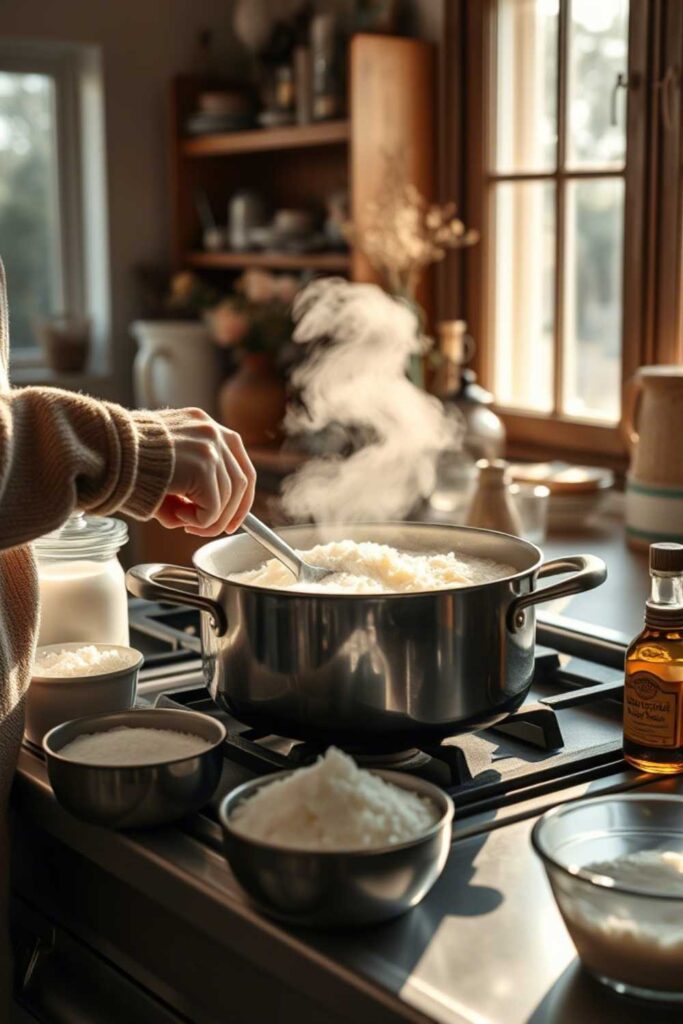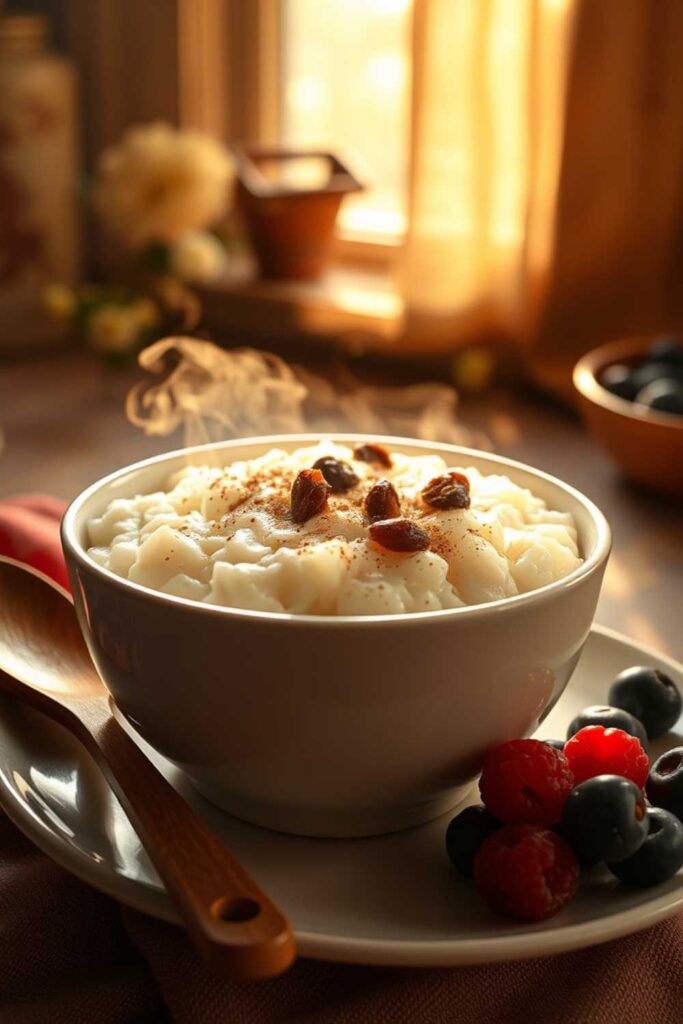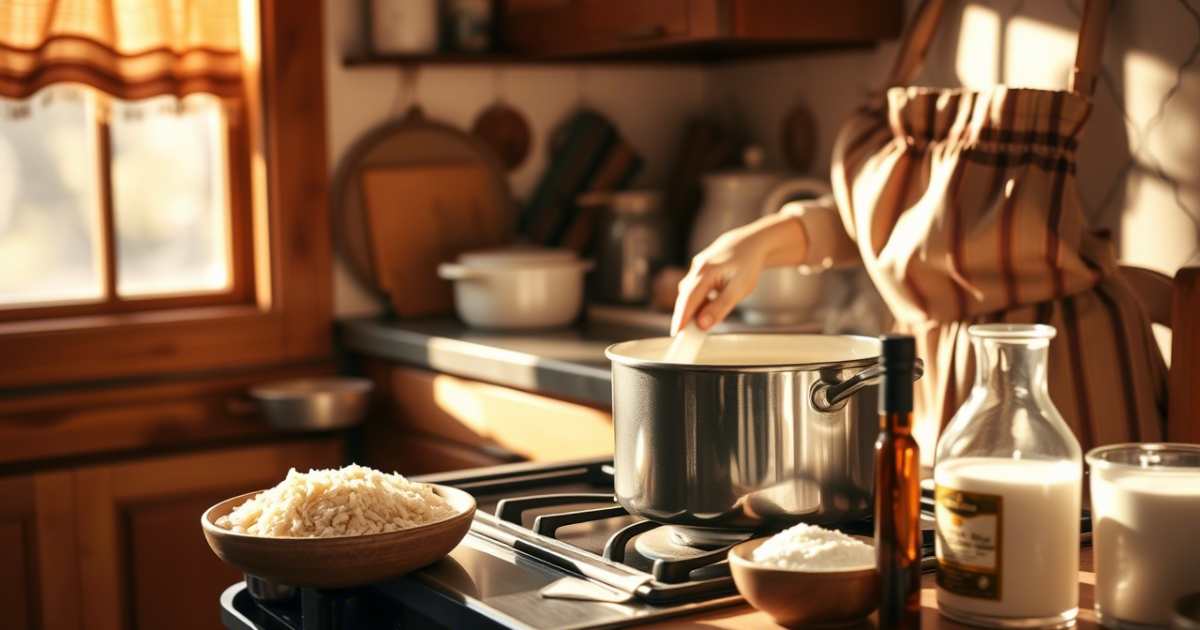You know that feeling when the smell of cinnamon, milk, and vanilla wraps around you like a thick old quilt? That’s old fashioned rice pudding for me. I remember my grandma stirring it in her dented, black-bottomed saucepan, muttering something about “low heat, child, low heat or it’ll scorch and ruin your whole afternoon.” She wasn’t wrong.
Rice pudding ain’t just a dessert. It’s a warm memory. It’s spoonfuls of comfort. It’s the humblest of ingredients made beautiful by patience. This isn’t the trendy kind with coconut milk or chia seeds (not judging, but c’mon). We’re going old school. Stove-top. Creamy. Silky but not mushy. Sweet, but not screaming. And oh, the smell when it hits the table—pure edible nostalgia.
Let’s roll up our sleeves and stir up something that tastes like it’s been passed down in whispers.
What Is Old Fashioned Rice Pudding and Why It’s Magic
Old fashioned rice pudding is a slow-cooked dessert made from rice, milk, sugar, and eggs, often flavored with vanilla, cinnamon, or nutmeg. Simple? Sure. But there’s nothing basic about the flavor when done right. It’s not instant. It doesn’t come from a packet. And if you’re in a hurry, you’re missin’ the point.
This dish has roots around the globe—arroz con leche in Latin America, riz au lait in France, kheer in India. But we’re sticking to the version your great-aunt Mabel might’ve made after Sunday supper.
Ingredients & Substitutions

Main Ingredients
- Whole milk (4 cups) – Don’t go skim here. You need the fat to get that luscious creaminess.
- Short-grain white rice (½ cup) – Arborio works beautifully. Long grain? Nah, too loose.
- Granulated sugar (⅓ to ½ cup) – Adjust depending on how sweet your tooth dances.
- Eggs (2 large) – For richness. Temper ‘em right or you’ll get scrambled sorrow.
- Salt (¼ teaspoon) – Just enough to make everything pop.
- Vanilla extract (1 tablespoon) – Go real or go home. I mean, if you’re gonna do this…
- Ground cinnamon (½ teaspoon) – Optional, but why would you not?
- Butter (1 tablespoon) – A dab of love at the end.
Substitutions & Notes
- Milk – Lactose-intolerant? Use oat milk, but don’t expect the same body. Creaminess suffers.
- Sugar – Maple syrup? Honey? You could, but then you’re in different territory.
- Rice – Jasmine has nice aroma, but careful—it cooks faster.
- Eggs – For veganizing, use cornstarch slurry, but again, that texture changes.
Pick ingredients like you’re picking teammates. You want the ones that show up and do the job right.
Step-by-Step Instructions
Step 1: Rinse the Rice
You might skip this, but don’t. Rinse that rice under cold water till the water runs mostly clear. It gets rid of extra starch, or else you’ll end up with gummy glue. You want creamy, not clumpy.
Step 2: Start the Simmer
In a heavy-bottomed saucepan, combine milk, rice, and a pinch of salt. Bring to a bare simmer—bare, not bubbling like a witch’s pot. Stir often, scraping the bottom. This is where burnt dreams begin if you’re careless.
Step 3: Low and Slow Is the Game
Let the rice cook gently for 45–55 minutes. Stir every 5–8 minutes. Don’t rush. The milk reduces, and the rice softens till it’s just a smidge chewy in the middle. Not mushy. Not raw. Somewhere lovely in between.
Step 4: Temper the Eggs
Whisk your eggs and sugar in a bowl. Now here’s the tricky bit. You need to temper the eggs by slowly whisking in a ladle of the hot pudding. Then another. Too fast and—boom—scrambled eggs. Once warmed, pour the egg mix back into the pot. Stir constantly. Heat for 2–3 minutes more, till it thickens. Not curdles, thicken.
Step 5: Finish with Flavor
Turn off the heat. Stir in the vanilla and that pat of butter. The smell? You’ll wanna swim in it.
Step 6: Let It Rest
Let it sit for 10 minutes before serving. Warm is lovely. Cold, next day? Even better, honestly. The texture tightens in the fridge. Stir in a splash of milk to loosen before reheating.
Expert Cooking Techniques & The Science Behind It

Why Whole Milk Matters
Fat content = mouthfeel. Skim won’t cut it. It turns out watery and sad. Whole milk gives that smooth, custard-like finish.
Stirring is Non-Negotiable
You’re cooking milk. On direct heat. Without stirring? You’ll scorch the bottom in minutes. Trust me, even seasoned chefs fall into the “just one minute away” trap. It never ends well.
Tempering Eggs is a Tightrope Act
If you just dump the eggs in, you’ll get flecks of cooked egg. Not cute. Not tasty. Warm them first. Gradually. Stir the whole time like you mean it.
Tools That Help
Heavy-bottomed saucepan is your BFF here. Avoid thin pots—they heat unevenly and burn faster. A wooden spoon helps you feel the drag at the bottom if things start to catch.
Serving & Pairing Suggestions
Serve warm with a dusting of cinnamon or nutmeg. Or drizzle of cream. Or nothing—it’s already stunning.
Pair it with:
- Strong coffee or espresso for contrast.
- A tart compote (cranberry or rhubarb) to cut the richness.
- A shot of spiced rum stirred in before serving—adults only, of course.
If plating for guests, try:
- Martini glasses with cinnamon sticks.
- Individual ramekins with a brûléed sugar crust (oh yes).
- Served cold with a splash of rosewater for a Middle Eastern vibe.
What Makes This Recipe Special?
It’s the time. The attention. The refusal to rush. You’re layering flavor and texture through slowness. This isn’t a microwave moment. It’s an act of edible meditation.
Plus, it uses pantry staples. No exotic hunts or $10 spices. It tastes like home, even if you’ve never had it before. And the best part? It’s forgiving. If you mess up a bit, it still tastes like a hug.
Final Expert Tips
- If your pudding’s too thick, add a splash of warm milk.
- Too sweet? Balance with a pinch more salt next time.
- If you see lumps, you probably overcooked or didn’t temper the eggs properly.
- Want extra richness? Sub a cup of milk for cream.
- Looking for crunch? Add toasted almonds or pistachios on top.
This is one of those recipes that gets better every time you make it. You learn its mood. You start to feel it in your hands.
FAQs
1. Can I use leftover cooked rice?
Yep, you can. But the texture won’t be as luscious. Use 2 cups of cooked rice and reduce milk by about a cup. Skip the long simmer, just warm and then temper eggs in like usual.
2. How do I keep it from sticking to the bottom of the pot?
Stir it like it owes you money. Especially in the first 30 minutes. A heavy-bottomed pot helps, too.
3. Is this gluten-free?
Yes, most old fashioned rice puddings are naturally gluten-free. Just check your vanilla extract and any add-ins.
4. Can I freeze rice pudding?
Technically yes, but it can get grainy. Better to keep it in the fridge for up to 4 days. Stir in a splash of milk when reheating.
5. How do I make it dairy-free?
Try oat or almond milk, and skip the eggs or use a cornstarch slurry. Just know—it won’t be quite the same. But it’ll still be cozy.
There you have it.
A dessert that doesn’t scream, but sings. Gentle. Familiar. Made with love and a little know-how.
Make it for someone who needs comfort. Or just for yourself, because sometimes, you’re the one who needs the warm bowl and the quiet spoon.








